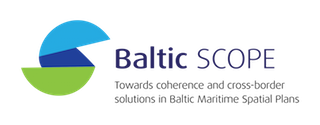Transboundary process of Stakeholder involvement into the activities of Baltic SCOPE
Stakeholder involvement in the Central Baltic case during the identification phase has taken place in two ‘Thematic Meetings’ and will be complemented with a larger ‘Stakeholder Conference’ in June, 2016 during the solution phase. The two thematic meetings were organised on sectoral basis, four expert groups composed by experts from Estonia, Latvia and Sweden, one for each of the sectors, including fisheries, energy, environment and shipping. These groups discussed the content from the point of view of the states and compared the differences between countries. Sectorial GIS-data and other information was collected in advance and after the thematic meetings. This allowed using directly the stakeholder’s input in the Topic Papers (sector specific) during their elaboration.
The second thematic meeting had a different approach than the first one. While in the first thematic meeting the sector-specific expert groups met separately, the second thematic meeting allowed for cross-sectoral discussions. The expert-groups had the opportunity to meet with the other groups using the ‘world café method’, where two expert groups meet at the time, and then they switch to meet with other groups until
each group has met all others. In this approach, the groups were able to discuss the issues identified so far for each sector and contrast them to the issues and interests of the other sectors.
The first thematic meeting allowed mainly to exchange specific and technical details for the different sectors, The result of such exchange is reflected on the sectoralbased Topic Papers (refer to Topic Papers for technical/sector specific details). With the data and information previously collected, the second thematic meeting dropped more concrete results to be taken to the next phase of the project (the solution phase). Namely, the second thematic meeting was used to identify and map the synergies and conflicts that exist or may appear in the future between the sectors in the use of transboundary maritime space. In addition, the experts discussed potential solutions to the identified conflicts. Without focusing on the technical aspects.
The next step will be to distinguish between the synergies and conflicts that are relevant on a national level only from those that have cross-sectoral/transboundary implications. Additionally, it will be necessary to distinguish between those issues that require planning solutions from those that are to be tackled through other management mechanisms.
Other reflections that emerged from the thematic meetings include:
- There is a need to have a more integrated look on the topics (literally, lay the different map layers on top of each other).
- The topic papers can be developed further as agreed during the topic meetings. These will not be finalised but taken as working documents until the end of the project.
- Comprehensive status report based on the topic papers is probably needed.
The solution phase will be used to seek solutions to the challenges identified by the expert groups during the thematic meetings. In doing so, the group is organizing a Stakeholder conference which will involve a greater number of actors from other ministries and authorities.





